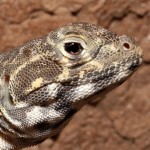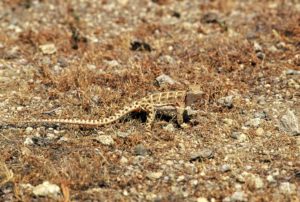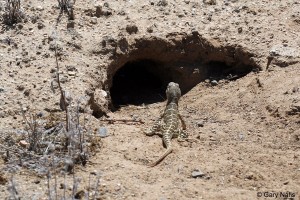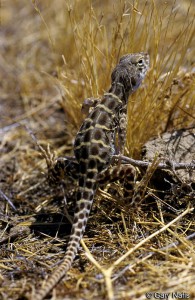Gambelia sila
- Endangered – Endangered Species Act (1967)
- Endangered – California Endangered Species Act (1971)
- Fully Protected Species – California Department of Fish and Game
- Endangered – IUCN Red List (2007)
- G1 Critically Imperiled – NatureServe
The blunt-nosed leopard lizard is a relatively large lizard with a body length ranging from 3 – 5 inches and a regenerative tail that is normally longer than the body—the lizard’s overall length can approach a foot long! As its name suggests, the blunt-nosed leopard lizard has large dark spots, as well as cream-colored bands, running the length of its body and a snout that’s relatively shorter than the related long-nosed leopard lizard (Gambelia wislizenii).
Habitat and Distribution
The blunt-nosed leopard lizard is found only in California, in the San Joaquin Valley and nearby valleys and foothills. The Carrizo Plain National Monument is one of the largest remaining population centers for the lizard; they occupy more than 87,000 acres of the national monument and are most abundant on the Elkhorn Plain in the southern portion of the Carrizo Plain.
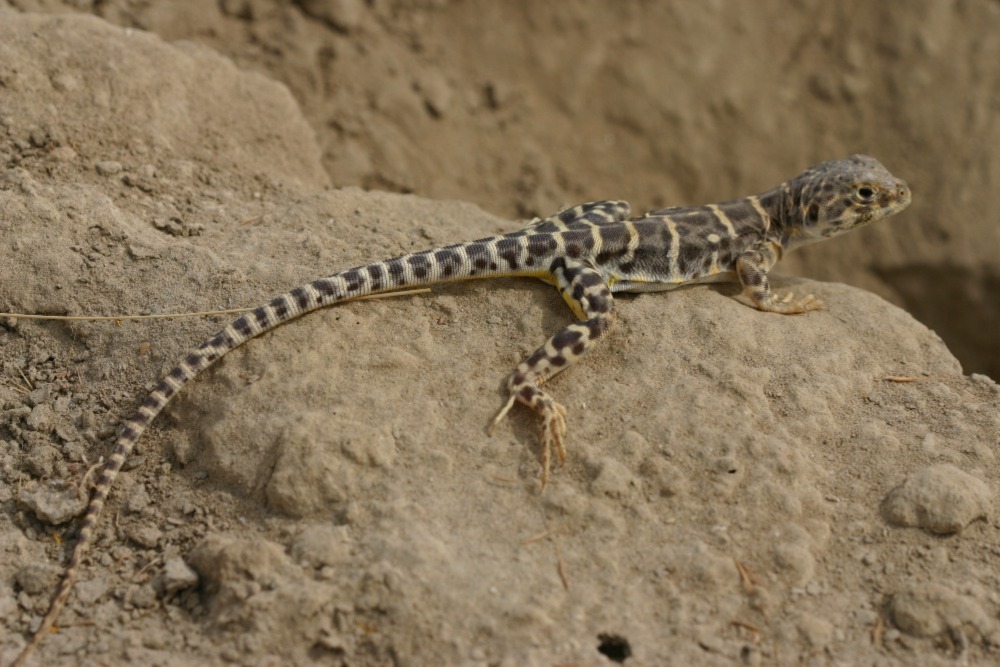
The blunt-nosed leopard lizard’s range extends across much of the Carrizo Plain National Monument as well as near—and possibly within—the Los Padres National Forest in the upper Cuyama Valley, where it converges with the range of the long-nosed leopard lizard. Besides the different snout lengths, these two species exhibit additional biological, ecological and behavioral differences, though they can hybridize. This makes the area of the national forest where these species meet particularly important, especially from a genetic and species conservation standpoint.
Diet and Behavior
Insects—mostly grasshoppers, crickets, and moths—comprise a major portion of their diet, but they are opportunistic and will feed on whatever prey they can get their claws on.
Blunt-nosed leopard lizards use small mammal burrows for shelter from predators, refuge from extreme temperatures, and dormancy periods. Typically these include abandoned ground squirrel tunnels and occupied and abandoned kangaroo rat tunnels, especially on the Carrizo Plain. These lizards are active during the warmer months of the year, and they hibernate in the winter. During the hot summer months, blunt-nosed leopard lizards rely on burrows to stay cool. However, recent research on the Carrizo Plain National Monument has shown that the presence of shade-providing shrubs in the area can allow these lizards to spend more time aboveground even when temperatures are high.
The breeding season starts in April and lasts through June. Male and female pairs are commonly seen at this time and the female will exhibit orange markings on her underside.
Threats
The former range of the blunt-nosed leopard lizard encompassed the floor of the San Joaquin Valley and Sierra Nevada foothills. The species also occurred on the Kettleman and Carrizo plains, and in the southeastern Cuyama Valley in San Luis Obispo, Santa Barbara, and Ventura counties.
Since the 1870s and the advent of large-scale irrigated agriculture in the San Joaquin Valley and subsequent loss of habitat, more than 95 percent of the original populations of blunt-nosed leopard lizard have been destroyed. Cultivation, construction of facilities related to oil and natural gas production, pesticide applications, off-road vehicle use, and general development in this area significantly reduced habitat extent and quality for the mammals whose burrows blunt-nosed leopard lizards rely on. This dramatic decline in its available habitat, and continued degradation of existing habitat, prompted state and federal biologists to classify the lizard as “endangered” under both the California Endangered Species Act and the federal Endangered Species Act.
In the Los Padres and surrounding habitat of the Cuyama Valley, possible threats include activities that remove habitat or crush burrows or individual lizards, such as oil drilling, off-road vehicle use, and livestock grazing.
Conservation
The blunt-nosed leopard lizard was one of the first species protected under federal law, listed as endangered by the U.S. Department of the Interior in 1967 (before the modern-day Endangered Species Act). It was also listed as a “fully protected species” by State of California in the 1960s and was subsequently listed as endangered in 1971. The “fully protected species” laws were enacted prior to the California Endangered Species Act and the federal Endangered Species Act to prohibit hunting, catching, or harvesting of specific threatened species.
To help bring the blunt-nosed leopard lizard back from the brink of extinction, federal biologists prepared a recovery plan in 1980 and it has gone through several revisions since. In early 2020, biologists at the U.S. Fish and Wildlife Service completed the latest Species Status Assessment (SSA) and Five-Year Review for the the blunt-nosed leopard lizard. The SSA and Review found that the criteria for the species to be either downlisted under the Endangered Species Act or removed from the list of endangered species altogether have not been met. The Review also identified the need for additional research and monitoring for the species, habitat restoration to improve connectivity between populations, and additional conservation measures on private lands.
No current overall population estimates are available for blunt-nosed leopard lizards. However, many large-scale surveys have taken place. The 2020 SSA and Review identified 24 populations (two of which were hybrid populations with the long-nosed leopard lizard), but the exact number of individuals is unknown. Design and implementation of a range-wide population monitoring program is still needed, as is protection of additional habitat in key portions of their range.
ForestWatch will continue to monitor threats to blunt-nosed leopard lizard populations in and around the Los Padres National Forest and the Carrizo Plain National Monument to help ensure the continued existence of this fascinating species.

